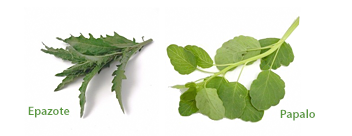Epazote and Papalo, fabulous South-of-the-Border herbs
By : alegria | 0 Comments | On : March 29, 2012 | Category : Alegria Fresh Newsletter
Unless you are very familiar with traditional Mexican and South American cuisine, there are two relatively unknown herbs hiding in your bouquet: epazote and papalo. These two herbs are staples in the south and chefs will often offer sprigs of papalo on the table so you can pluck the leaves and add them to your meal raw to foods, much like finding parsley or mint on a dish in a restaurant.
Epazote’s use in food and medicine can be traced all the way back to the Aztecs, who called it epazotle, which means “smelly animal.” The scientific name is Chenapodium ambrosioides, although it is also commonly referred to as pigweed, skunkweed, wormseed, goosefoot or Mexican tea.
These less-than-elegant names are given to epazote due to its strong, pungent flavor and its scent, which has been compared to citrus, mint, and even gasoline. Epazote adds a tasty kick to a variety of dishes. It is most often found in connection with legumes, especially black beans. Epazote has strong anti-flatulence properties and is known to help treat other ailments, including asthma, malaria, and the eradication of intestinal parasites.
Epazote should be used carefully, as it has a very strong taste and can be toxic in very large doses. Younger leaves are milder than older leaves, which should be used more sparingly. To store, treat epazote like fresh parsley: cut off its stem ends, refresh with cold water, and store in a wet paper towel in the fridge. You can also eat the flowering ends.
Papalo is found in abundance in Mexican and South American cuisine. Its scientific name is Papaloquelite porophyllum ruderale or macrocephalum. The name papalo comes from the Nahuatl word, papalotl or butterfly, because of its resemblance to butterfly wings. It is sometimes referred to as Bolivian coriander, although it is actually part of the daisy family and has no relation to coriander. Additionally, because of its tolerance to heat and its similarities to cilantro, it is often referred to as summer cilantro.
Papalo’s taste is similar to cilantro with a dash of arugula, and therefore is often used in the same dishes as cilantro. However, its use actually predates cilantro in salsas, and in some parts of the South America cilantro is only used in guacamole and salsas if papalo is not available. Papalo has a much stronger taste than cilantro; therefore, it should be used in lower quantities. In addition to being used in salsas, raw papalo is often added to dishes at the last minute, preserving its strong, unique flavor.
Like epazote, papalo helps to ease stomach issues that can arise from the spicy, bean heavy foods found in Mexican and South American cuisine. Other common medicinal functions are the treatment of liver ailments and reducing high blood pressure due to its vasodilating properties.
The papalo and epazote found in your Alegria Farm bouquet will impart the strongest flavors because they have been picked an hour before their delivery and are at their peak nutrition.
Papalo Salsa from the Gourmet Sleuth: http://alegrialiving.com/recipe/papalo-salsa-from-the-gourmet-sleuth/



